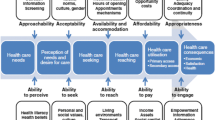Abstract
Oregon's systematic design for universal access to health care, known as the Oregon Basic Health Services Act, has provoked heated debate over its rationale, plan and process. It is a novel attempt to address inequities in the distribution of health care for those below the federal poverty level. Its controversial nature compels more informed discussion to guide further analysis. Accordingly, this report is primarily descriptive, aiming to provide a clear synopsis of the Oregon project's history, complex methodology, and strengths and weaknesses.
Similar content being viewed by others
References
Oregon Health Services Commission (1991).Prioritization of Health Services: A Report to the Governor and Legislature. Oregon Health Commission, Portland, Oregon.
Fox, D. M. and Leichter, H. M. (1991). Rationing care in Oregon: the new accountability.Health Affairs 10(2), 7–27.
Menzel, P. T. (1991). Oregon's denial: disabilities and quality of life.Hastings Center Report 22(6), 21–25.
Crawshaw, R., Garland, M. J., Hines, B. and Lobitz, C. (1985). Oregon health decisions: an experiment with informed community consent.Journal of the American Medical Association 254(22), 3213–3216. Oregon Health Commission, Portland, Oregon.
Hadorn, D. C. (1991). The Oregon priority-setting exercise: quality of life and public policy.Hastings Center Report 21(3), 11–16.
Oregon Health Services Commission (1992).The Oregon Health Plan: Revised Priority List, 30 October 1992. Oregon Health Commission, Portland, Oregon.
Dougherty, C. J. (1991). Setting health care priorities: Oregon's next step.Hastings Center Report 21(3), 1–10.
Capron, A. M. (1992) Oregon's disability: principles or politics?Hastings Center Report 22(6), 18–20.
Veatch, R. M. (1991). Should basic care get priority? Doubts about rationing the Oregon way.Kennedy Institute of Ethics Journal 1(3), 187–206.
Goldsmith, M. F. (1989). Oregon pioneers ‘more ethical’ Medicaid coverage with priority-setting project.Journal of the American Medical Association 262(2), 176–177.
Callahan, D. (1991). Ethics and priority setting in Oregon.Health Affairs 10(2), 78–87.
Dougherty, C. J. (1988).American Health Care: Realities, Rights, and Reforms, Oxford University Press, New York.
Packwood, B. (1990). Oregon's bold idea.Academic Medicine 65(11), 623–633.
Brown, L. D. (1991). The national politics of oregon's rationing plan.Health Affairs 10(2), 28–51.
Gore, Jr. A. (1990). Oregon's bold mistake.Academic Medicine 65(11), 634–635.
LaPuma, J. and Lawlor, E. F. (1990). Qualityadjusted life-years: ethical implications for physicians and policymakers.Journal of the American Medical Association 263(21), 2917–2921.
Klein, R. (1992). Warning signals from Oregon.British Medical Journal 304, 1457–1458.
Nelson, R. M. and Drought, T. (1992). Justice and the moral acceptability of rationing care: the Oregon experiment.Journal of Medicine and Philosophy 17(1), 97–117.
Author information
Authors and Affiliations
Rights and permissions
About this article
Cite this article
Brannigan, M. Oregon's experiment. Health Care Anal 1, 15–32 (1993). https://doi.org/10.1007/BF02196966
Issue Date:
DOI: https://doi.org/10.1007/BF02196966




